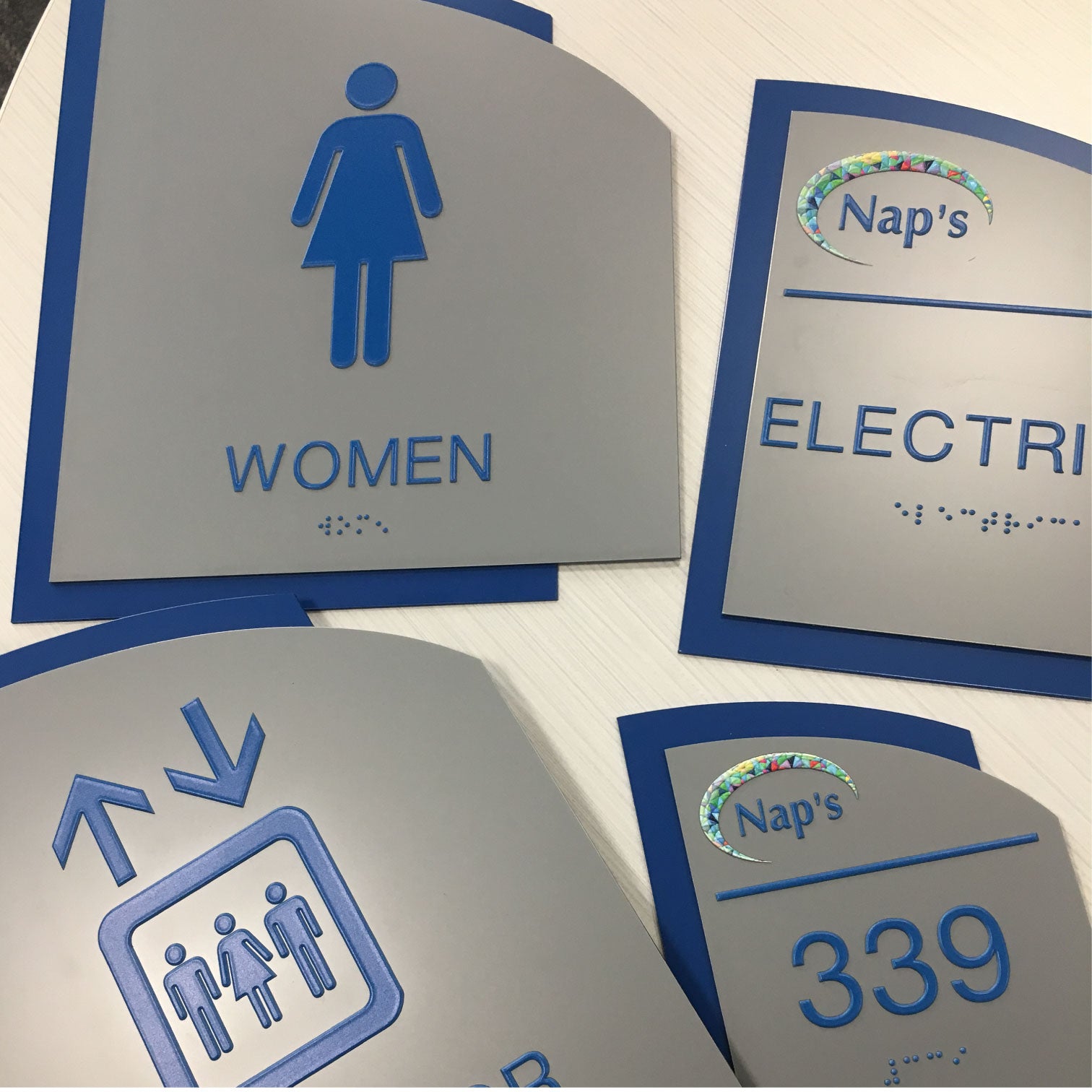Discover the Significance of ADA Signs in Public Spaces
Discover the Significance of ADA Signs in Public Spaces
Blog Article
Discovering the Trick Attributes of ADA Indicators for Improved Availability
In the world of accessibility, ADA indicators serve as silent yet effective allies, guaranteeing that rooms are comprehensive and navigable for people with disabilities. By incorporating Braille and responsive elements, these indications damage barriers for the visually damaged, while high-contrast shade schemes and readable fonts cater to varied aesthetic needs.
Relevance of ADA Compliance
Making sure conformity with the Americans with Disabilities Act (ADA) is vital for fostering inclusivity and equal accessibility in public spaces and offices. The ADA, established in 1990, mandates that all public facilities, companies, and transportation services fit people with handicaps, ensuring they take pleasure in the very same civil liberties and opportunities as others. Compliance with ADA requirements not only meets lawful obligations but likewise improves a company's online reputation by showing its dedication to variety and inclusivity.
One of the vital facets of ADA compliance is the implementation of accessible signs. ADA indications are developed to ensure that people with specials needs can quickly navigate with buildings and spaces.
Furthermore, adhering to ADA policies can minimize the risk of prospective penalties and legal effects. Organizations that stop working to abide by ADA standards may face claims or penalties, which can be both monetarily difficult and damaging to their public image. Hence, ADA compliance is indispensable to promoting a fair environment for every person.
Braille and Tactile Aspects
The unification of Braille and responsive elements into ADA signage symbolizes the concepts of access and inclusivity. It is normally placed beneath the matching text on signs to make sure that people can access the info without aesthetic aid.
Tactile components expand past Braille and consist of increased characters and signs. These elements are created to be noticeable by touch, enabling individuals to identify area numbers, toilets, leaves, and various other important locations. The ADA sets specific standards pertaining to the dimension, spacing, and placement of these tactile components to enhance readability and make sure consistency throughout various atmospheres.

High-Contrast Color Pattern
High-contrast color schemes play a pivotal duty in improving the presence and readability of ADA signs for individuals with visual disabilities. These schemes are vital as they optimize the distinction in light reflectance in between message and history, guaranteeing that indications are quickly noticeable, even from a range. The Americans with Disabilities Act (ADA) mandates using details color contrasts to suit those with minimal vision, making it an essential facet of compliance.
The efficiency of high-contrast colors hinges on their ability to stick out in various illumination problems, including poorly lit environments visit this website and areas with glow. Generally, dark message on a light background or light text on a dark history is used to achieve ideal comparison. Black text on a yellow or white background offers a plain aesthetic difference that aids in fast acknowledgment and understanding.

Legible Fonts and Text Dimension
When considering the design of ADA signs, the selection of understandable typefaces and proper text size can not be overstated. The Americans with Disabilities Act (ADA) mandates that typefaces have to be not italic and sans-serif, oblique, manuscript, extremely decorative, or of uncommon kind.
According to ADA guidelines, the minimal text height ought to be 5/8 inch, and it ought to increase proportionally with watching distance. Consistency in text size contributes to a cohesive aesthetic experience, assisting individuals in browsing environments successfully.
Additionally, spacing between letters and lines is indispensable to legibility. Ample spacing stops characters go to this site from appearing crowded, boosting readability. By adhering to these requirements, designers can dramatically improve access, guaranteeing that signs serves its designated objective for all individuals, regardless of their aesthetic capabilities.
Efficient Positioning Strategies
Strategic positioning of ADA signs is important for making the most of access and guaranteeing compliance with lawful criteria. Correctly positioned indicators guide individuals with specials needs properly, facilitating navigation in public areas. Key factors to consider include exposure, elevation, and closeness. ADA guidelines stipulate that indications need to be mounted at a height in between 48 to 60 inches from the ground to guarantee they are within the line of view for both standing and seated people. This standard height range is vital for inclusivity, making it possible for mobility device customers and people of differing elevations to gain access to info effortlessly.
Furthermore, signs need to be placed surrounding to the latch side of doors to permit simple identification prior to entry. Uniformity in indication positioning throughout a facility boosts predictability, decreasing complication and enhancing overall individual experience.

Verdict
ADA signs play a vital role in promoting accessibility by integrating features that address the needs of people with disabilities. These components jointly cultivate a comprehensive atmosphere, highlighting the significance of ADA compliance in ensuring equivalent accessibility for all.
In the world of availability, ADA indications serve browse around this site as silent yet powerful allies, making certain that rooms are inclusive and accessible for people with specials needs. The ADA, passed in 1990, mandates that all public facilities, companies, and transport services accommodate people with specials needs, ensuring they enjoy the very same legal rights and opportunities as others. ADA Signs. ADA signs are developed to ensure that individuals with disabilities can conveniently browse via structures and rooms. ADA standards state that signs need to be installed at a height in between 48 to 60 inches from the ground to ensure they are within the line of view for both standing and seated individuals.ADA indicators play a vital duty in promoting accessibility by incorporating attributes that address the requirements of individuals with handicaps
Report this page